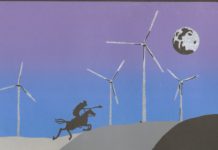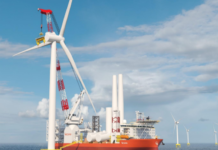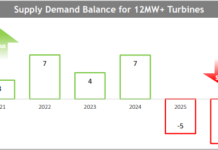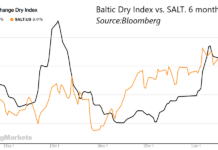by Michael Giberson
American University’s Investigative Journalism Workshop has published reports detailing the extensive political connections in the United States developed by Chinese wind power company A-Power Energy (APWR) in its effort to build a 600-MW wind farm in West Texas. A-Power (APWR) and their Chinese and American partners were seeking $450 million in section 1603 grants and U.S. Department of Energy loan guarantees to help fund the project. New York senator Charles Schumer objected to the idea that stimulus funds would flow to Chinese workers and sought to block the project’s access to the funds. A-Power chose to fight politics with politics, announcing a turbine factory in Nevada (home of the Senate Majority Leader Harry Reid, project being developed in conjunction with prominent Reid supporters in Las Vegas) and making friends with the United Steelworkers union which had initially opposed the project.
The key U.S. partner to A-Power on the project is U.S. Renewable Energy Group, described in the article as “a Dallas investment firm with strong ties to Washington and the Democratic Party.” On its website, US-REG describes itself as a developer of “renewable energy projects throughout the nation,” but the only project specifically mentioned anywhere on its website is the proposed project with A-Power (here is the US-REG summary touting the benefits of the proposed project). Reading the “About the Team” materials on the website suggests a group of very well-connected lawyers and investors with little direct experience in developing renewable energy projects.
In this particular story, a key company is Chinese and the well-connected movers and shakers are Democratic, but there is nothing especially “Chinese” or “Democratic” about the practice of political capitalism revealed here.
Earlier reports from the Investigative Journalism Workshop detailed that about 88 percent of the section 1603 grant money went to non-U.S. based companies, including companies from Spain, Germany, Japan, and Portugal. (Note that the location of the corporate headquarters likely has little to do with where the money gets spent or who ends up better off because of the subsidy.) Another report indicated that $1.3 billion in stimulus funds went to wind power projects built before the stimulus bill was passed.
A US-REG press release issued in response to the article complains that it “contained a number of biased statements and inaccuracies about US-REG and its Texas wind farm project.” But they don’t do a point by point rebuttal, mostly just reaffirm what a wonderful thing the project will be. Well, to be fair, their response specifically claims: no U.S. government money has been received (they WANT a lot, but they haven’t received any yet and it begins to look unlikely unless the Section 1603 program is extended), and no U.S. government official has been asked to intervene with the DOE loan guarantee application.
The response also specifically claims “Without these federal incentives, most American wind projects would be forced to lay off workers, go out of business or sit idle until energy prices rise, further stalling much needed growth in the American renewable sector.”
I think they could have been clearer: without the incentives, the wind power companies would not have hired workers in the first place, so those workers would have been engaged in other kinds of productive work instead, perhaps even self-sustaining lines of work not dependent on continuing federal incentives.
NOTE via Seeking Alpha: Recent financial filings by A-Power suggest that the West Texas project will not get built. If the project does not receive Section 1603 grants and the DOE loan guarantee by December 31, 2010, A-Power’s partners have the right to dissolve the partnership. They report, “In our view, it is not likely that Spinning Star [the project’s name] will be able to arrange the requisite construction financing by December 31,2010….”
Added: HT to the Dallas Morning News Texas Energy and Environment blog.
Michael Giberson teaches Energy Economics and Energy Policy at the Center for Energy Commerce in Texas Tech University’s Rawls College of Business. This post is a revised version of an article that first appeared at the Knowledge Problem blog.








Since China and America are two growing countries and growing relationship, there is an understanding towards both parties that they already know certain things like ruling, leadership, and many more.
Claudine